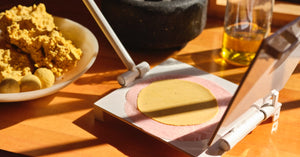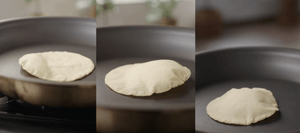Comal Care: A seasoning guide to Made In x Masienda Comal
Comal Care: A seasoning guide to Made In x Masienda Comal

November 10, 2021
What's up with seasoning?
Seasoning is the process of treating the surface of Comal with a non-stick coating formed from polymerized oil, which fill the small pores of its surface. A healthy layer of seasoning, also known as patina, will protect your Comal from rust and create a one-of-a-kind non-stick surface.
To achieve an even seasoning, a thin layer of high-smoke-point oil should be applied to the surface of our Carbon Steel Comal and then heated.
The temperature to which Comal should be heated will vary depending on the oil used. As Comal is heated, the surface color will begin to darken. While the coloring may be uneven at first, over time--and with regular use--the color will even out.
How to season your Carbon Steel Comal: Two Methods
We recommend two methods for seasoning your Carbon-Steel Comal.
***For both methods, be sure to clean Comal before the first seasoning, using warm soapy water and a sponge. This is the only time you will use soapy water or a sponge. Ensure Comal is fully dried before beginning your seasoning process.***
Method #1: Oven Seasoning Method
- Preheat your oven to 400-450 F. The oven temperature should be at or slightly above the smoke point of your oil; most high-smoke-point oils fall in the 400-450 F smoke-point range.
- Once your oven is preheated, place your dry and empty Comal on the stove over medium-low heat for 2-3 minutes to dry any remaining moisture and open up Comal's pores.
- Use a paper towel to apply a very thin layer of oil to the entire cooking surface and inner lip of Comal, ensuring it is completely coated (you may also choose to remove it from the burner to do so).
- Move your hot, oiled pan to the oven and place it upside down on the center rack.
- Leave the pan in the oven for an hour. You may see or smell some light smoke, which is totally normal!
- After one hour, turn your oven off and leave the pan in the oven until it’s completely cooled.
Your pan is now ready to be used, or you can repeat these steps as many times as you’d like to continue building that seasoning. More seasoning translates to more slickness and more even searing (a pillar of the coveted tortilla puff).
Check out this video to see the process from start to finish for seasoning Comal using the oven method:
Method #2: Standard Cooktop Seasoning Method
- Heat your Comal over medium-low heat for 2-3 minutes on your stovetop (your grill would also work). This ensures Comal is heated thoroughly and helps open up the pores as well as helps to dry Comal completely after washing. The surface color may already begin to change-this is normal and expected as it creates its patina.
- After heated thoroughly, use a paper or hand towel to apply a thin layer of oil to the entire surface of Comal. Fold over the towel and wipe away as much of the oil as you can to ensure a thin layer is all that remains.
- Let Comal sit on the burner or grill over medium-low heat, rotating it as needed, in order to ensure it is heated evenly up the sides as well. The color will continue to change yielding shades of blue, brown, black, or even orange (these colors are normal!). After about 5 minutes, remove Comal from the heat and let it thoroughly cool. It’s ready for use, or you can repeat the process for additional surface slickness.
- Comal will continue to season with each use, and only gets better over time. If you won’t be using it for more than a week or two, we recommend applying a thin layer of oil to help protect Comal from moisture, which can cause rust on the surface. Take a look at our steps below for troubleshooting, if rust does indeed develop (don't panic, it's an easy fix!).
Do I need to season the Seasoned Comal?
If you've purchased the Seasoned Carbon Steel Comal, good news: the first two seasonings have been taken care of, so it's nearly ready to go! Before your first use, rinse, dry and then wipe the pan’s surface with a very thin layer of a neutral oil (e.g. grapeseed, avocado, or canola) and heat over medium-high for 2 minutes or until it starts smoking. This quick step helps maintain its naturally non-stick finish and keeps your tortillas, steak, and veg releasing beautifully. And we recommend repeating this step with every use until you’re satisfied with its non-stick performance.
So, no heavy scrubbing or complicated curing required — just heat, add a bit of oil, wipe, and cook.
Cleaning & Storing Comal
Like a cast-iron skillet, you have to be careful when cleaning your carbon-steel Comal. Soap and scouring pads will strip Comal of all that seasoning you've worked to develop and the non-stick properties that came with it. Instead, we recommend sticking to the points outlined below.
Steps to clean your Comal:
- If your Comal is relatively clean, you'll only need to gently wipe it down with a paper towel or dishtowel to remove any excess oil or food bits.
- In the event that food is stuck or burnt to Comal's surface, you'll need a little water to loosen the debris. Again, DO NOT USE SOAP OR A SOAKING BATH. Gently scrub the schmutz off with a bristle brush or sponge (never a scouring pad) and use a small amount of water.
- When you’re done rinsing off the food residue, dry Comal and put it over medium-low heat on your stovetop for two to three minutes. This will help dry any moisture remaining on the surface of Comal.
- If the process of drying your Comal causes its surface to lose some slickness, it is best to re-season Comal.
- Once Comal is clean, you can either store it with your other pans or let it live on your stovetop, like we do. If you happen to live in a place with higher humidity or don't intend to use Comal for a while, apply a very thin coating of oil to the surface to prevent rusting before you put it away. As a general rule of thumb, your Comal should always have a slick and slightly oiled surface.
Common Seasoning Questions
Q: How do I know the smoke point of my oil?
A: Many oils will have the smoke point listed directly on the bottle. If yours does not, you can refer to our list of common oils below. Keep in mind that smoke points can vary depending on the extraction method, source, etc., so consider these temperatures as approximate guides when approaching your own oil at home.
- Canola Oil: 400º-450ºF
- Flaxseed Oil (Unrefined): 250º-325ºF
- Peanut Oil: 400º-450ºF
- Sesame Oil (Unrefined): 350ºF
- Sesame Oil (Semi-refined): 450ºF
- Sunflower Oil: 425º-450ºF
- Grapeseed Oil: 425ºF
- Vegetable Oil: 425ºF
- Avocado Oil (Expeller-Pressed/Refined): 500ºF
Q: I feel like I followed these instructions but my Comal is tacky/sticky. Que pasó?
A: From our experience, one of two things most likely happened: Either too much oil was used (we want a thin layer, remember) or your oil's smoke point may have been slightly higher than your oven temperature (meaning, it did not cook fully into Comal's surface).
If you're finding you applied a thicker layer, try wiping the surface to remove any excess on your next round of seasoning. In the case of your smoke point not matching the oven temperature, try adjusting your oven temperature to 15-20º higher than the smoke point, next time around.
If you’d like to start over and remove your seasoning, you can use steel wool, chainmail, or even sandpaper to scrape away as much of the sticky residue as possible. You may see some of the "bare" metal when you do this, which is normal and expected. The dark color that Comal's surface has when you receive it isn't a coating, despite how it appears. It is actually just oxidation of the metal, which occurs when the pan goes through an annealing process (it is heated in a special oven to 400ºC that has steam injected, causing the surface to oxidize, which helps protect from rust in transit). Then re-season your Comal with the correct amount of oil and temperature.
Q: My Comal is rusting! Can I still use it?
A: Don't worry! Rust will naturally occur if Comal isn’t fully dried and/or if Comal isn’t stored with a thin layer of oil on the surface to keep it from drying out. It can be easily scrubbed away with a steel wool, and then you can apply a bit of oil to ensure Comal doesn’t dry out.
Q: The surface of my Comal began to peel after I cooked with it, exposing bare metal!
A: Believe it or not, there is no coating on Comal. The blue color is an intentional oxidation of the metal, which occurs when Comal goes through its annealing (i.e., heating and cooling) process. It's likely that the peeling is either a thick patch of oil or food residue. To remove, you can apply another layer of seasoning or continue cooking as normal, until the surface is evenly restored.



All Comments
Hi Judith! You absolutely can. Let us know how they turn out!
CAN I use my good cast iron frying pan to cook masa tortilla?
(I am not in favor of seasoning a comal and smoke points bec I do not want my smoke detector to go off. I OR I can invest in a better non stick I guess. JUST wondering abt the cast Iron with a film of hi smoke point OIL
thanks for your reply
J Nicholais
Hi CW! Thanks so much for your note. By chance, are you using your comal on an electric or induction stovetop? For best results, we recommend using it over a gas flame or live fire. The comal isn’t reliable compatible with electric or induction burners, and that can lead to warping, uneven cooking, or surface discoloration. Let us know your setup and we’re happy to help troubleshoot. 😊
warm greetings,
my comal is a favorite pan of mine…but…i keep wondering – the comal is higher in the middle – is that normal? purpose? i get uneven cooks and oily sides. doesn’t seem quite right. thanks for any insight, solution..info.
cw
Hi Claudia! Thanks for your question. For best results, heat your comal over a gas stovetop or live flame. The comal is not reliably compatible with induction burners or electric stovetop and may warp during use or lead to uneven cooking and surface discoloration. Please note that returns on comals that are used on electric or induction stoves cannot be accepted.